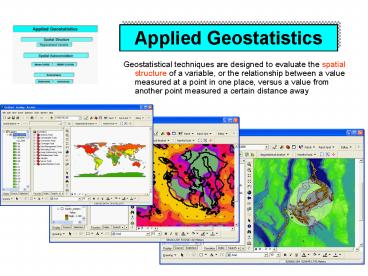Applied Geostatistics - PowerPoint PPT Presentation
1 / 13
Title:
Applied Geostatistics
Description:
Randomly arranged. Illustrated on directional trend. Features. are. We assume either: ... pattern is one of many possible arrangements of the population; or ... – PowerPoint PPT presentation
Number of Views:340
Avg rating:3.0/5.0
Title: Applied Geostatistics
1
Applied Geostatistics
Geostatistical techniques are designed to
evaluate the spatial structure of a variable, or
the relationship between a value measured at a
point in one place, versus a value from another
point measured a certain distance away
2
Ho in Spatial Statistics states that
- events,
- highs,
- lows,
- differences between
- evenly distributed
- Randomly arranged
- Illustrated on directional trend
Features
are
3
We assume either
Randomization - the observed pattern is one of
many possible arrangements of the population or
Normalization the observations is a sample of a
larger population and it was obtained randomly
4
We consider
Global statistics pattern across the whole of
the study area
Local statistics individuals relationship with
nearby features
5
Spatial Mean
- The average x-coordinate and average y-coordinate
for all features in the study area (or select
set). - Comparing changes in spatial distributions
6
Central Feature
- The feature having the shortest total distance
to all other features in the study area (or
select set) - Describes the most accessible feature
Mean
Center
7
Standard Distance, Standard Deviational Ellipse
- The extent to which the distances between the
mean center and the features vary from the
average distance. - The standard deviation of the features from the
mean center separately for the X and Y coordinates
8
Linear Directional Mean
- The angle of the line that represents the mean
direction (or orientation )
9
J I H B
G C F
D A E
Join Count
- Categorical (nominal) data
- Are values clustered or dispersed
- Easy to construct
First Order Neighbors Topology Binary
Connectivity Matrix
Distance Class Connectivity Matrix
A B C D E F G H I J
A B C D E F G H I J
A B C D E F G H I J
A B C D E F G H I J
1 connected, 0not connected
10
Morans I Gearys C
- Continuous data
- Similarity of nearby features
- Single statistics summarizing pattern
- Doesnt indicate clustering of highs or lows
11
General-G
- Continuous data
- Concentration of high/low
- Not so good if both highs and lows are
clustered
12
Nearest Neighbor
- Average distance between features
- Results may be biased by edge
- Evaluated with Z-score
13
K-function, Ripleys-K
- Count of features within defined distances
- Concentration at a range of scale
- Edge plays an important role
- Evaluation through simulations for random
distribution envelope
























![Download ⚡️[EBOOK]❤️ Art Therapy and Health Care 1st Edition PowerPoint PPT Presentation](https://s3.amazonaws.com/images.powershow.com/10073583.th0.jpg?_=20240705126)






